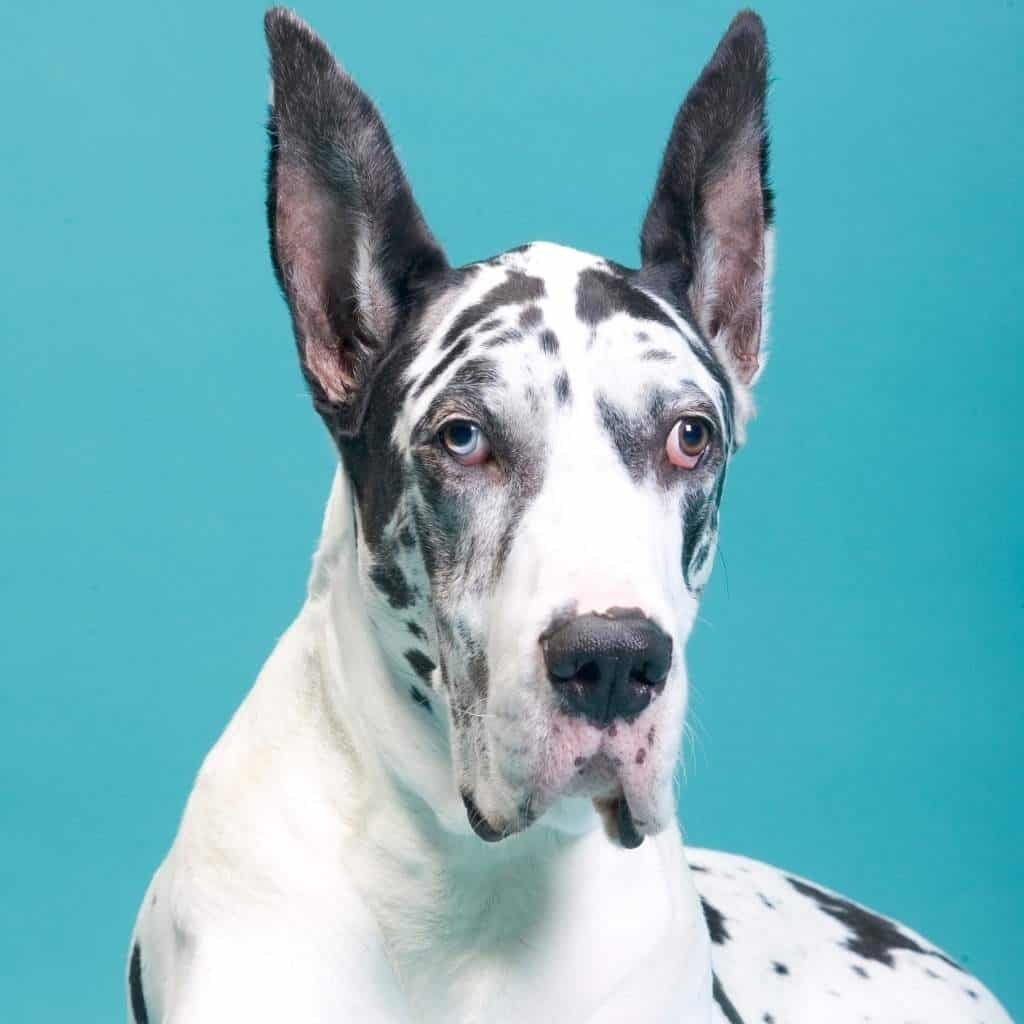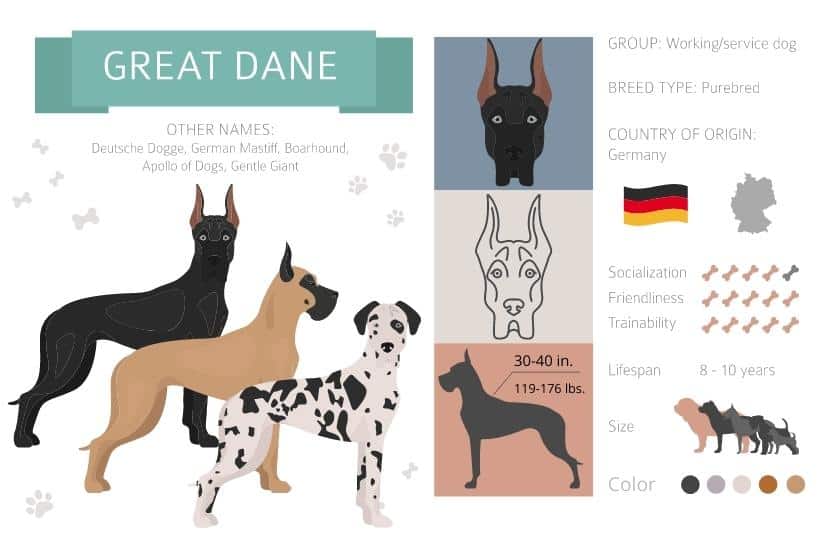All About the Great Dane Husky Mix
When it comes to unique dog combinations, none is bigger (or more adorable) than a Great Dane Husky mix! Also known as a Great Danesky, this breed is a blend of…you guessed it…a Great Dane and a Siberian Husky.
Thinking about adopting a Great Danesky?
Today on Doggie HQ, our dog experts go over everything you need to know.

Why People Love the Great Dane Husky Mix Breed
There is an old saying that goes, “Everyone thinks they have the best dog in the world. And none of them are wrong.”
For Great Danesky owners, this statement rings especially true. People adore the Great Dane Husky mix for a multitude of reasons. They make a fabulous companion for people who want a gentle giant that stands out from the crowd.
For example, a Great Danesky is:
- Large
- Friendly
- Intelligent
- Active
- Confident
- Outgoing
- Playful
- Good with kids
These traits make them paw-sitively perfect additions for many families. Oh, and one final bonus! A Great Danesky will drool less than a purebred Great Dane.
What’s not to love?
Breed Histories
As mentioned previously, the Great Danesky is a mix between a Great Dane and a Husky. This could mean their mother or father was one of each or could possibly be a result of selective generational breeding. Regardless, the Great Danesky will reflect both breeds.
Historically speaking, Great Danes are originally from Germany. The breed itself is over 400 years old. Most likely, the line was developed from crossing the English Mastiff with the Irish Wolfhound, though some sources suggest the breed is much more ancient.
What we do know for sure is that Great Danes had jobs. According to the American Kennel Club (AKC), Great Danes were once kept by noble families and used to hunt wild animals, such as boar, deer, and bears. Due to their large size, Great Danes also made excellent protectors. They defended homes from intruders.
A loud and deep chested “woof” was enough to send thieves running!
In time, Great Danes were used less for hunting and more for companionship. Nowadays, these gentle giants are mostly couch potatoes.

On the other hand, Siberian Huskies hail from northeastern Asia. Pet MD explains that the Chukchi people – an Indigenous group in Siberia – bred these dogs for sled pulling and to be working pets. Huskies had the thick coats and endurance necessary to survive the harsh, cold climate. Later, they were brought to North America. A Russian fur trader named William Goosak introduced them to Alaska during the gold rush of the late 1800’s. From there, their popularity exploded.
Of course, huskies still compete in sled races. But unless you live in the Arctic, you’re far more likely to see a husky trotting on leash in an urban setting.
In fact, in 2020 they held the #16 spot on the AKC’s list of most popular dog breeds, right behind the Great Dane at #15!
Overview of the Great Dane Mixed with a Husky
Depending on whether your Great Danesky is a male or female, their adult size/weight will vary. After all, hybrid dog genetics are unpredictable.
But generally speaking, you can expect these traits.
- Size: 21-35 inches
- Weight: Approximately 130 lbs
- Temperament/Personality: Laidback, friendly, affectionate, intelligent, independent, stubborn, can be protective
- Lifespan: Between 8 – 13 years
- Unique Qualities: Good walking and outdoor companions, can be trained as therapy dogs
- Do they shed: This differs. Great Danesky coats tend to be short, resulting in minimal shedding. Yet it is possible for them to inherit a thicker coat. Daily grooming will keep dead fur and dander to a minimum.
- Hypoallergenic: No.
- Health Issues: Bloat (also known as gastric dilatation-volvulus) is the main concern and can be life threatening if left untreated. Other common issues include: hip dysplasia, heart disease, bone and joint problems, and eye cataracts
- Family Friendly: Yes. However, due to their enormous size, a rambunctious and energetic Great Danesky puppy requires constant supervision around children and seniors. Also, be warned! Huskies have high prey drives. Small mammals, like guinea pigs and cats, may not be ideal housemates for a Danesky.
Overall, the Great Dane Husky mix makes a lovely pet. Regular veterinarian checkups, proper nutrition, and adequate training are essential to keeping your Great Danesky happy and healthy.

What does a Great Danesky look like?
Now, you may be thinking, “Wait. I’ve never seen a Great Danesky before. What do they actually look like?”
This is where the breed gets interesting!
No two Great Dane Husky mixes will look exactly alike. That’s because their Great Dane half comes in a wide variety of colors, such as:
- Merle
- Blue
- Brindle
- Black
- Fawn
- Harlequin
- Mantle
Chances are that a puppy will display the same coloring as their parent. Fawn is the most popular Great Dane color – think Scooby Doo!
Most will also have floppy ears, long necks, and a skinny tail. Occasionally, a Great Danesky might have blue eyes. For this beautiful facial feature, they have their husky side to thank. The fur will be short and sleek.
No matter their color, the Danesky’s body will be muscular, powerful, and elegant.
How big does a Danesky get?
Everybody knows Great Danes eat…a lot!
But how big does a Danesky actually get? Will that tiny furball puppy turn into a giant overnight? The answer is once again, complicated. Yes, a Great Dane Husky mix will be on the larger end. Standing on their back legs, a purebred Great Dane can be as tall as a human. And huskies are medium-sized dogs.
That means owners should prepare for a bigger than average dog.
Yet, Great Dane Husky mixes do surprisingly well in smaller spaces. So long as they get enough daily exercise and have roomy sleeping quarters to stretch out, this breed can exist comfortably in both apartments and houses.
Are Great Dane Husky mixes aggressive?
No.
Great Dane Husky mixes are not aggressive by nature. Honestly, they would rather lick you to death giving wet kisses than growl or bite! That being said, as with any large breed dog, it’s paramount that proper training and socialization takes place to prevent future behavior problems from developing.
Dog Time gives both the Great Dane and the Siberian Husky 5-stars in terms of friendliness to strangers. Introduce them to new people when young. And don’t skip the puppy classes.
Common Health Issues in a Dane Husky Mix
Sadly, giant breed dogs live shorter lives. The bigger the dog, the faster they age.
Common health issues include:
- Bloat
- Hip dysplasia
- Cardiovascular disease
- Hypothyroidism
- Joint problems
- Cancer
- Wobbler Syndrome
- Eye cataracts

Is a Great Dane Mixed with Husky Easily Trainable?
Proper training is key to having a well-behaved pet.
Without training, dogs are prone to having potty accidents, jumping, barking excessively, leash pulling, boredom, and even risk becoming destructive.
Luckily, a Great Danesky wants to please! This makes them trainable. Both Great Danes and Huskies are highly food motivated. Small chunks of sausage or cheese make fantastic rewards. Occasionally, a Great Danesky will have a stubborn streak…that’s the Husky in them! To combat this, offer lots of enrichment and positive praise.
Husky Great Dane Mix Adoptions and Rescues
Given that this is an uncommon hybrid, it’s rare to find a Danesky up for rescue. Similarly, shelters often don’t have the resources to complete accurate genetic testing. However, millions of dogs currently live in animal shelters. They are waiting for a loving home – like yours!
Why not browse for Great Dane Husky mixes?
Websites such as Petfinder.com and AdoptaPet.com have breed search fields. Another great resource is Great Dane Rescue Inc.
Best Place to Find Puppies
So, now you are seriously considering a Great Dane Husky mix?
Congratulations!
The best place to find a Great Danesky puppy is through a reputable breeder. Understandably, this can be quite difficult. The Great Danesky is still a rather new “designer dog.” To find one, join a local Great Dane or Husky club and talk to those with real-world connections to dog enthusiasts.
Avoid puppy mills. If somebody offers to sell you a Danesky – but is hesitant to let you meet the parents – stay away! Always ask:
- If you can meet the mother and father?
- Whether there are any genetic issues?
- What kind of health guarantee is provided?
- Are you welcome to do a home visit?
What about cost?
According to Bubbly Pet, a puppy will cost between $800 – $1000+ if purchased from a reputable breeder.
Final Thoughts
As you no doubt see, the Great Danesky is an extraordinarily special dog breed. They are giant goofballs who fill homes with love. But before rushing out to buy a Great Dane Husky mix puppy, remember to do your research.
That way, you can truly enjoy your new Great Danesky!





